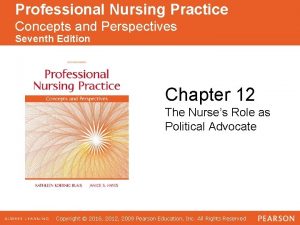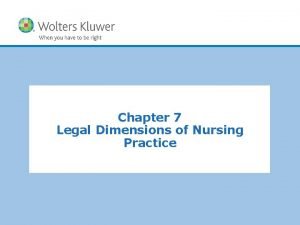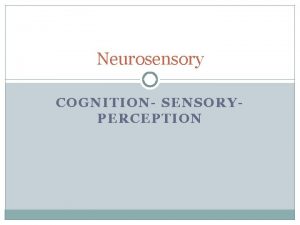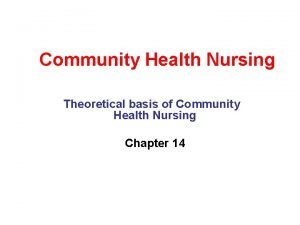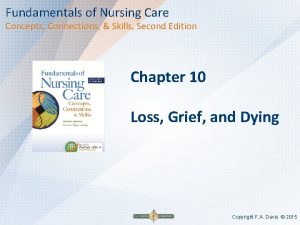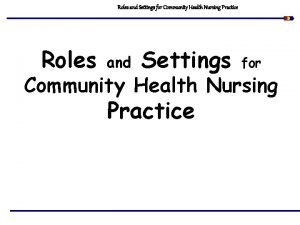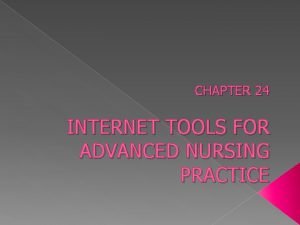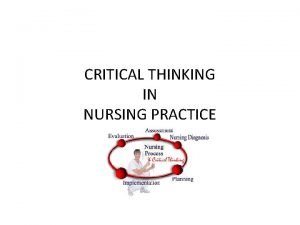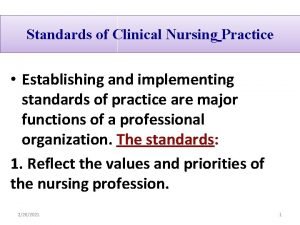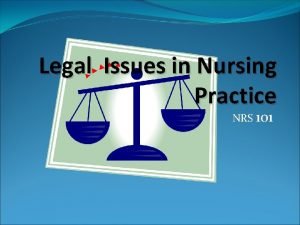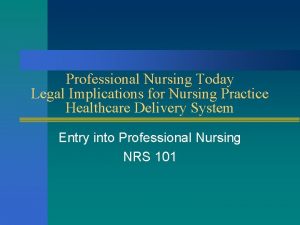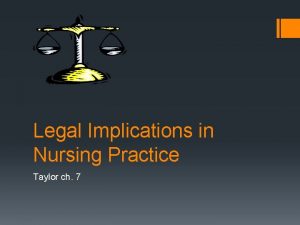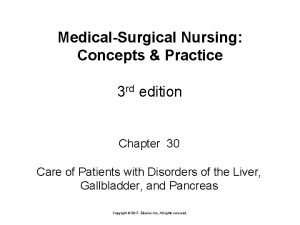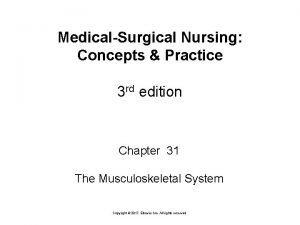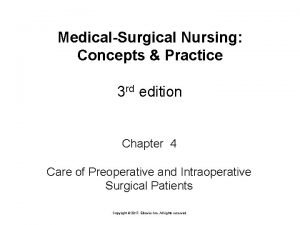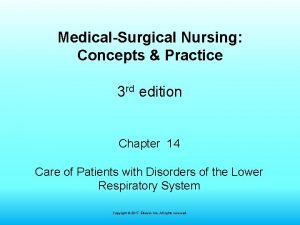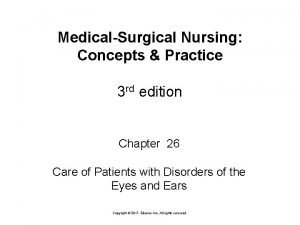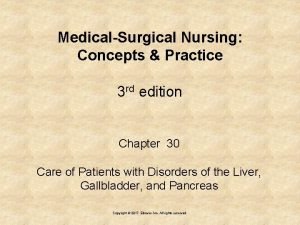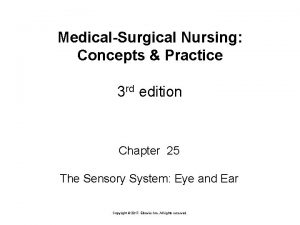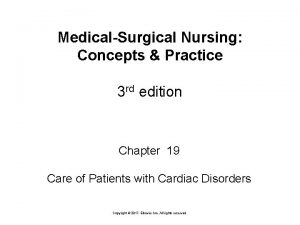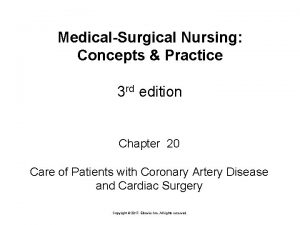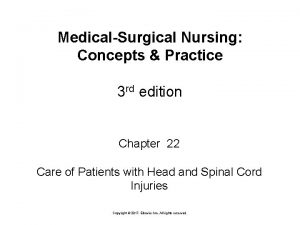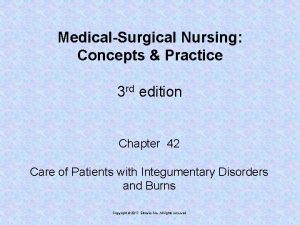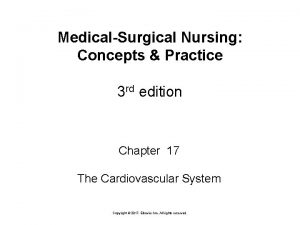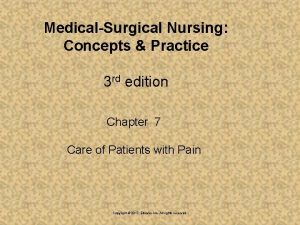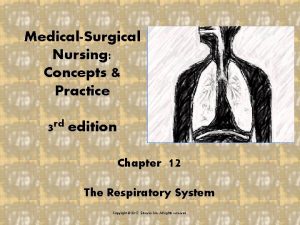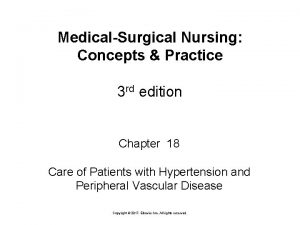MedicalSurgical Nursing Concepts Practice 3 rd edition Chapter
















































- Slides: 48

Medical-Surgical Nursing: Concepts & Practice 3 rd edition Chapter 16 Care of Patients with Hematologic Disorders Copyright © 2017, Elsevier Inc. All rights reserved.

Anemia Etiology Ø Ø Ø Anemia resulting from blood loss Anemia resulting from a failure in blood cell production Anemia associated with an excessive destruction of red blood cells Copyright © 2017, Elsevier Inc. All rights reserved. 2

Older Adult Care Points There is about a 20% incidence of anemia among older adults, most often caused by poor nutrition. Shock may develop with smaller blood loss in this group because of decreased vascular tone and impaired cardiac function. Copyright © 2017, Elsevier Inc. All rights reserved. 3

Anemia Pathophysiology Signs and symptoms Diagnosis Treatment Copyright © 2017, Elsevier Inc. All rights reserved. 4

Copyright © 2017, Elsevier Inc. All rights reserved. 1

Pathophysiology of Iron Deficiency Anemia Copyright © 2017, Elsevier Inc. All rights reserved. 6

Signs and Symptoms of Severe Anemia General Eyes Skin Cardiovascular Respiratory Gastrointestinal Musculoskeletal Neurologic Copyright © 2017, Elsevier Inc. All rights reserved. 7

Nursing Management of Anemia Focused assessment Ø Ø Ø Health history Physical assessment Pertinent laboratory values Copyright © 2017, Elsevier Inc. All rights reserved. 8

Expected Outcomes Within 1 month, the patient will be able to perform hygiene, dressing, and grooming activities without needing to rest between activities. Within 2 months, the patient will be able to carry out usual daily activities without shortness of breath or fatigue. Copyright © 2017, Elsevier Inc. All rights reserved. 9

Expected Outcomes (Cont. ) The patient will eat three nutritious meals daily containing sufficient iron, folic acid, vitamin C, and protein. The patient will verbalize understanding of dietary and medication regimen within 1 week. Copyright © 2017, Elsevier Inc. All rights reserved. 10

Planning Intervention is based on an understanding of the particular kind of anemia affecting the patient. Ø Ø For patients with anemias that interfere with clotting and that tend to cause bleeding episodes, nursing actions are directed toward preventing the episodes. For patients with anemia severe enough to cause fatigue, assist with activities of daily living and provide planned rest periods. Copyright © 2017, Elsevier Inc. All rights reserved. 11

Implementation Nursing functions include Ø Ø Ø Administering blood, iron, vitamin B 12, and folic acid Monitoring for desired effects Educating patients about needed dietary adjustments Copyright © 2017, Elsevier Inc. All rights reserved. 12

Older Adult Care Points Iron supplements should be taken 1 hour before or 2 hours after a meal as long as they don’t cause gastrointestinal distress. Many older people have chronic conditions that require daily medications. Antacids and many other drugs interfere with iron absorption. Check all drugs a patient is receiving to determine whether drug interactions might interfere with iron absorption. Copyright © 2017, Elsevier Inc. All rights reserved. 13

Pathophysiology of Pernicious Anemia Copyright © 2017, Elsevier Inc. All rights reserved. 14

Aplastic Anemia Diagnosis Treatment Health promotion Copyright © 2017, Elsevier Inc. All rights reserved. 15

Pathophysiology of Aplastic Anemia Copyright © 2017, Elsevier Inc. All rights reserved. 16

Sickle Cell Disease Etiology Pathophysiology Signs and symptoms Diagnosis Treatment Copyright © 2017, Elsevier Inc. All rights reserved. 17

Sickling of Red Blood Cells From Ignatavicius DD, Workman ML: Medical-surgical nursing: patient-centered collaborative care, ed. 7, Philadelphia, 2012, Elsevier Saunders. Copyright © 2017, Elsevier Inc. All rights reserved. 18

Nursing Management Patient teaching Ø Ø Ø Avoid high altitudes, vigorous exercise, and iced liquids. Maintain adequate fluid intake. Refrain from smoking. Treat infections promptly. Adequate rest Adequate pain relief Monitor intake and output. Oxygen therapy Copyright © 2017, Elsevier Inc. All rights reserved. 19

Polycythemia Vera Cause Signs and symptoms Treatment Ø Ø Ø Phlebotomy, antineoplastic agents, and radiation therapy Increased fluid intake Aspirin Copyright © 2017, Elsevier Inc. All rights reserved. 20

Leukemia Etiology Pathophysiology Signs and symptoms Diagnosis Treatment Copyright © 2017, Elsevier Inc. All rights reserved. 21

Older Adult Care Points Patients older than the age of 65 years require reduced doses of chemotherapeutic drugs (to prevent toxicity) because they have decreased kidney and liver function, and the drugs are not metabolized as quickly as in younger people. Copyright © 2017, Elsevier Inc. All rights reserved. 22

Causes of Clinical Signs of Leukemia Severe infections Symptoms of anemia Enlarged spleen, liver, and lymph nodes Weakness, pallor, and weight loss caused by an elevated metabolic rate Renal pain, urinary stones and obstruction to flow of urine, and urinary tract infection Headache, disorientation, and other central nervous system symptoms Copyright © 2017, Elsevier Inc. All rights reserved. 23

Nursing Management Potential for infection Abnormal bleeding Anemia Nutritional alteration with severe anorexia and weight loss Increased levels of uric acid in the urine and blood (due to chemotherapy) Psychosocial problems related to the effects of the disease as well as the prescribed treatment Copyright © 2017, Elsevier Inc. All rights reserved. 24

Thrombocytopenia Causes Nursing care Ø Ø Prevention of bleeding Close observation for signs of spontaneous bleeding and quick intervention Invasive procedures only when essential Avoid activities that might induce bleeding. Copyright © 2017, Elsevier Inc. All rights reserved. 25

Copyright © 2017, Elsevier Inc. All rights reserved. 1

Safety Alert: Prevent Bleeding For a patient with a low platelet count, whenever venipuncture is performed, an injection is administered, or an intravenous catheter or needle is discontinued, pressure over the site must be maintained for 10 minutes to prevent continuous oozing. Copyright © 2017, Elsevier Inc. All rights reserved. 27

Ecchymoses of the Hand from Thrombocytopenia From Lewis SL, Heitkemper MM, Dirksen SR, et al: Medicalsurgical nursing: assessment and management of clinical problems, ed. 7, St. Louis, 2007, Mosby. Copyright © 2017, Elsevier Inc. All rights reserved. 28

Multiple Myeloma Etiology and pathophysiology Signs, symptoms, and diagnosis Treatment Copyright © 2017, Elsevier Inc. All rights reserved. 29

Nursing Management Provide supportive care for the many complications of the disease and treatment. Encourage adequate hydration with an intake of 3 to 5 L of fluid a day to minimize problems from hypercalcemia. Assess and manage pain—acetaminophen and nonsteroidal anti-inflammatory drugs and narcotic analgesics. Carefully move the patient because of the potential for fractures. Copyright © 2017, Elsevier Inc. All rights reserved. 30

Assignment Considerations When enlisting a nursing assistant to help with positioning, moving, or toileting the patient, remind the person that the patient is very prone to bruising, bleeding, or fractures as the case may be. Do not assign ambulation of a patient with multiple myeloma to assistive personnel; any slight bump or twist of the body may cause a fracture. Copyright © 2017, Elsevier Inc. All rights reserved. 31

Hemophilia Etiology Pathophysiology Signs and symptoms Diagnosis and treatment Copyright © 2017, Elsevier Inc. All rights reserved. 32

Copyright © 2017, Elsevier Inc. All rights reserved. 1

Safety Alert: Avoid Taking Aspirin must never be taken by patients with hemophilia because aspirin increases the bleeding problems. Patients must read the labels on every overthe-counter preparation to be certain that drug products do not contain aspirin or acetylsalicylic acid. Copyright © 2017, Elsevier Inc. All rights reserved. 34

Nursing Management Administer the necessary clotting factors. Elevate the injured body part. Apply cold packs. Control pain. Observe for further bleeding. Provide psychological support for the patient and family. Encourage genetic counseling for family members, if this counseling has not occurred previously. Copyright © 2017, Elsevier Inc. All rights reserved. 35

Aspiration of the Knee to Relieve Hemarthrosis From Roberts JR, Hedges JS: Clinical procedures in emergency medicine, ed. 5, Philadelphia, 2009, Saunders. Copyright © 2017, Elsevier Inc. All rights reserved. 36

Disseminated Intravascular Coagulation Etiology Diagnosis Treatment Nursing management Ø Ø Ø Be alert to the possibility of DIC when a patient has predisposing conditions. Early detection of external bleeding Monitoring sensorium and vital signs for indications of internal bleeding Copyright © 2017, Elsevier Inc. All rights reserved. 37

Management of Hematologic Disorders Leukapheresis Biologic response modifiers: colonystimulating factor therapy Bone marrow and stem cell transplantation Copyright © 2017, Elsevier Inc. All rights reserved. 38

Legal and Ethical Considerations The patient must have signed a consent form to receive a blood transfusion. If the patient is unable to sign, the condition is life threatening, and no family member is reachable, the physician may make the decision to transfuse the patient. Copyright © 2017, Elsevier Inc. All rights reserved. 39

Check the LPN/LVN Role Some states have expanded their LPN practice act to include the administration of blood products. Check your nurse practice act to see if that procedure is within legal practice in your state. Copyright © 2017, Elsevier Inc. All rights reserved. 40

Older Adult Care Points Vessels in older adults are fragile. Ø A 22 -gauge cannula may be used for transfusion to older adults rather than an 18 -gauge cannula. Blood products should be transfused more slowly to allow the older person’s body time to adjust to the added fluid. Careful assessment for fluid overload during and after the transfusion is essential. Signs of fluid overload are rapid bounding pulse, hypertension, and visibly swollen veins. Copyright © 2017, Elsevier Inc. All rights reserved. 41

Signs and Symptoms of a Transfusion Reaction Chills Fever Shortness of breath Itching or rash Apprehension Sense of impending doom Headache Pain in the low back or chest Tachycardia Tachypnea Hypotension Hemoglobinuria (hemoglobin in the urine) Shock Copyright © 2017, Elsevier Inc. All rights reserved. 42

Copyright © 2017, Elsevier Inc. All rights reserved. 1

Cultural Considerations Most people willing to donate bone marrow are white. There is a 30% to 40% chance of a human leukocyte antigen (HLA) match for a white patient and donor marrow. Copyright © 2017, Elsevier Inc. All rights reserved. 44

Cultural Considerations (Cont. ) Far fewer African Americans have signed up at the bone marrow registry, and the chance for an HLA match for an African American patient is less than 20%. Efforts are being made to encourage African Americans to become bone marrow donors. Copyright © 2017, Elsevier Inc. All rights reserved. 45

Acute Transfusion Reactions Acute hemolytic reaction Febrile, nonhemolytic reaction (most common) Mild allergic reaction Anaphylactic and severe allergic reaction Circulatory overload Sepsis Copyright © 2017, Elsevier Inc. All rights reserved. 46

Management of Hematologic Disorders Oxygen therapy Iron therapy Vitamin B 12 therapy Splenectomy Ø Ø Ø Severe trauma to and rupture of the spleen Splenomegaly caused by rapid destruction of blood cells Splenomegaly from blood disorders, such as leukemia Copyright © 2017, Elsevier Inc. All rights reserved. 47

Community Care Support groups Home care: parenteral medications, including chemotherapy Patient teaching Coordination of care Copyright © 2017, Elsevier Inc. All rights reserved. 48
 Health promotion in nursing practice 7th edition
Health promotion in nursing practice 7th edition Professional nursing practice concepts and perspectives
Professional nursing practice concepts and perspectives Human genetics concepts and applications 10th edition
Human genetics concepts and applications 10th edition Operating system
Operating system Operating system concepts 6th edition
Operating system concepts 6th edition Database system concepts seventh edition
Database system concepts seventh edition Kariogram človeka
Kariogram človeka Mis chapter 6
Mis chapter 6 Using mis (10th edition) 10th edition
Using mis (10th edition) 10th edition Fundamentals of nursing chapter 15 critical thinking
Fundamentals of nursing chapter 15 critical thinking Chapter 7 legal dimensions of nursing practice
Chapter 7 legal dimensions of nursing practice Legal implications of nursing documentation
Legal implications of nursing documentation Cost-benefit analysis concepts and practice
Cost-benefit analysis concepts and practice Interrelated concepts nursing
Interrelated concepts nursing Interrelated concepts nursing
Interrelated concepts nursing Fundamentals of nursing care concepts connections & skills
Fundamentals of nursing care concepts connections & skills Role community health nurse
Role community health nurse Leadership theory and practice 6th edition
Leadership theory and practice 6th edition Computer security principles and practice 4th edition
Computer security principles and practice 4th edition Modern real estate practice in pennsylvania 14th edition
Modern real estate practice in pennsylvania 14th edition Medical law and ethics 5th edition
Medical law and ethics 5th edition Computer security principles and practice 4th edition
Computer security principles and practice 4th edition Graphical display
Graphical display Myeplg website
Myeplg website Unit practice council nursing ideas
Unit practice council nursing ideas Oncology nursing society putting evidence into practice
Oncology nursing society putting evidence into practice Model of professional nursing practice regulation
Model of professional nursing practice regulation Jcaho nursing
Jcaho nursing Nursing definition by nightingale
Nursing definition by nightingale Nursing dimensional analysis practice
Nursing dimensional analysis practice Internet tools for advanced nursing practice
Internet tools for advanced nursing practice Oklahoma board of nursing supervising physician
Oklahoma board of nursing supervising physician Neuman's system model
Neuman's system model Critical thinking example in nursing
Critical thinking example in nursing Standards of clinical nursing practice
Standards of clinical nursing practice Theoretical foundation of nursing test question
Theoretical foundation of nursing test question Legal issues in nursing practice
Legal issues in nursing practice Johnson nursing theory
Johnson nursing theory Translating research findings to clinical nursing practice
Translating research findings to clinical nursing practice Systems-based practice
Systems-based practice 14 component of virginia henderson
14 component of virginia henderson Practice drift in nursing
Practice drift in nursing Abraham maslow siblings
Abraham maslow siblings Florida nursing practice act
Florida nursing practice act Legal implications in nursing practice
Legal implications in nursing practice Posortho
Posortho Legal dimensions of nursing practice
Legal dimensions of nursing practice Difference between team nursing and modular nursing
Difference between team nursing and modular nursing Nursing interventions for hoarding disorder
Nursing interventions for hoarding disorder

